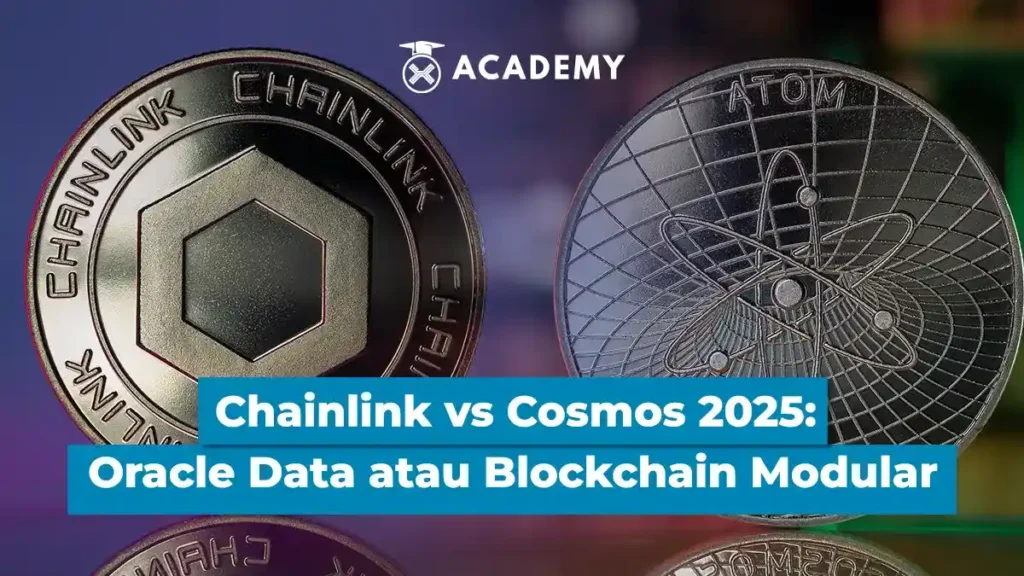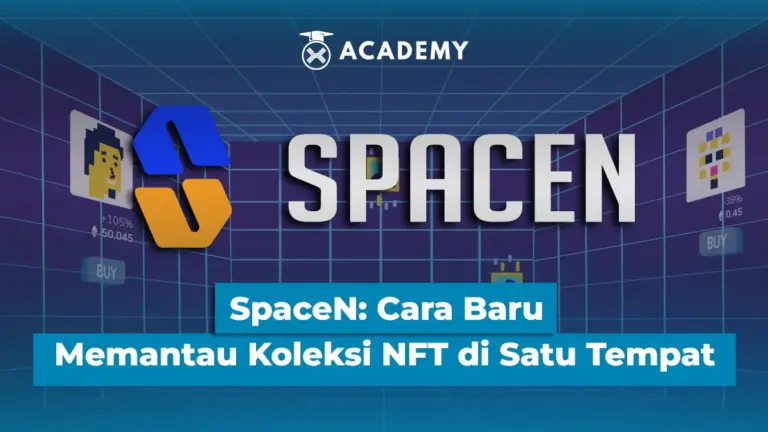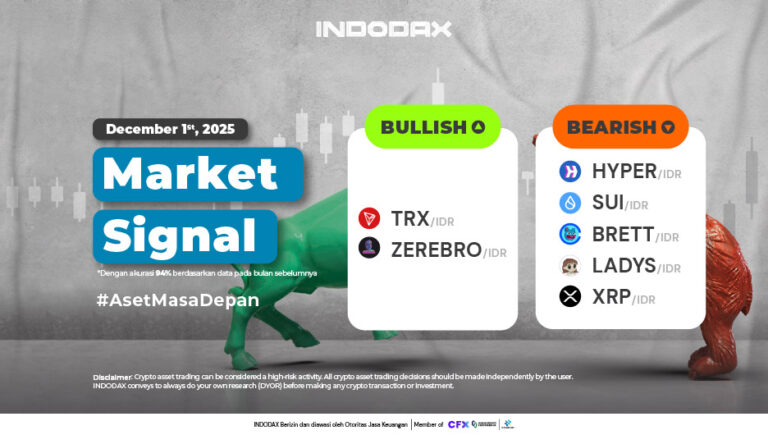Chainlink and Cosmos are now two key players in the crypto world of 2025. But behind their popularity, they are actually moving on very different paths, both in terms of their roles and visions.
So, which one has a greater place in the future evolution of blockchain technology? Well, to find out, read the following review.
Project Philosophy: Trusted Oracle vs. Internet of Blockchains

Before delving into a technical comparison of Chainlink and Cosmos, it’s important to understand the underlying philosophy of each project. Although both operate in the blockchain infrastructure space, they have different missions.
Chainlink exists to address a crucial issue: how blockchains can access data from outside their systems.
Due to the closed and deterministic nature of blockchains, smart contracts need a “bridge” to read real-world data.
Chainlink fills this role as a decentralized oracle, connecting the blockchain to external data such as prices, weather, and even match scores.
Without oracles like Chainlink, real-time data-driven applications on blockchains are nearly impossible.
Since its inception as SmartContract.com and its huge success in its ICO, Chainlink has grown to become the gold standard in the oracle world, even partnering with big names like Google.
Cosmos, meanwhile, has a broader vision: building the “internet of blockchains.” The goal isn’t to create a single, super-powerful blockchain, but rather to form a network of independent blockchains that can be interconnected via the IBC protocol.
Cosmos promotes a modular approach where each blockchain, or “zone,” can be tailored to meet specific needs, whether for DeFi, NFTs, or enterprise. All these zones can communicate with each other through the central Cosmos Hub.
This paves the way for a more open, scalable, and flexible ecosystem.
Core Technology: Oracle Protocol vs. Cosmos SDK + IBC
Chainlink and Cosmos share fundamental technology, but their focuses are very different. Chainlink is a decentralized oracle protocol that allows smart contracts to access external data.
Features like data feed aggregators, VRFs, and CCIP make it a crucial component in DeFi, from asset prices on DEXs to random numbers in Web3 games to interoperability between blockchains.
All data on Chainlink is validated through a node selection process and multi-source aggregation, ensuring accuracy and preventing manipulation, which is crucial in the high-value DeFi ecosystem.
Cosmos, on the other hand, is building a modular blockchain ecosystem that can be natively interconnected. Through the Cosmos SDK and IBC, developers can create custom blockchains that can still communicate with each other.
Powered by the Tendermint BFT consensus, Cosmos solves blockchain fragmentation by offering interoperability and liquidity across networks, opening the door to more flexible DeFi.
Real-world Use: Data Feed or Blockchain Ecosystem?
Chainlink and Cosmos are both crucial infrastructure in the crypto ecosystem, but their uses in practice are very different.
Chainlink is typically used as an add-on component to strengthen other projects, while Cosmos serves as the foundation upon which new blockchains are built.
Chainlink is used behind the scenes by many major DeFi projects. Aave, Synthetix, and dYdX all utilize Chainlink oracles to incorporate real-world data into their smart contracts.
Furthermore, Chainlink also supports stablecoins, real-world assets (RWA) projects, and verified randomness systems for Web3 games.
In these cases, Chainlink isn’t a platform for building applications, but rather the “data brain” that many protocols require to function reliably.
Cosmos takes on a very different role: it’s not just a tool, but a core platform.
Through the Cosmos SDK, projects like Osmosis (DEX), Injective (derivatives), Celestia (modular data availability), and Sei (trading layer) are built from the ground up on the Cosmos framework.
These are not “dApps on Cosmos,” but rather independent blockchains interconnected through the IBC protocol.
Cosmos not only provides tools but also offers an architectural philosophy that each blockchain can be independent, yet interconnected within a single ecosystem.
In other words, Chainlink is a data provider integrated into other ecosystems, while Cosmos is the ecosystem itself.
Chainlink enriches smart contract functionality with data, while Cosmos provides a platform for building new, fully autonomous yet interoperable blockchains.
Both have high strategic value: one as a data hub and the other as a multichain ecosystem framework.
Scalability, Cost, and Ecosystem Expansion
In terms of large-scale readiness, Chainlink and Cosmos have very different, but equally ambitious, paths. Chainlink is not layer-1 or a place to build direct applications; that is precisely its strength.
Because it’s neutral and modular, Chainlink is already integrated into nearly every major ecosystem, from Ethereum, BNB Chain, Avalanche, Polygon, Arbitrum, to Solana.
This allows Chainlink to be ubiquitous without being confined to the constraints of a single blockchain.
With the Cross-Chain Interoperability Protocol (CCIP), Chainlink is even building an inter-chain data and messaging network that could become the backbone of Web 3 communications.
Cosmos takes the opposite approach: building from the ground up. Through the Cosmos SDK, projects can create custom blockchains tailored to their own needs, complete with their own logic, tokens, and consensus.
Unlike traditional dApps that rely on the throughput of a single network, Cosmos-based blockchains like Osmosis or Injective don’t share the load.
Each can scale independently and connect to each other via IBC. This is Cosmos’s main strength: modularity and horizontal scalability.
Cosmos is also more flexible in terms of fees. Because each chain has its own parameters, transaction fees are determined by the architecture and traffic of each network. There’s no single bottleneck or global bottleneck.
In contrast, because it relies on other layer-1 networks, Chainlink adopts a fee model that mirrors that of its host platform.
On Ethereum, fees can be expensive. On layer-2 networks, they can be much cheaper. Chainlink adjusts, but doesn’t directly control fees.
Essentially, Cosmos’s advantage lies in its ability to build a scalable and modular network, where each blockchain can be tailored to a specific function and interconnected through IBC.
Chainlink excels in scalability and cross-ecosystem adoption, becoming the data backbone wherever the blockchain resides.
Cosmos builds interconnected “new roads,” while Chainlink builds “data bridges” over existing ones. Two different approaches, but both crucial for the future of Web 3.
Security & Decentralization: Data Networks vs. Cross-Chain Validation
Chainlink and Cosmos both prioritize security, but the foundations they build on are very different.
Chainlink is not a layer-1 blockchain, but rather an oracle network that relies on independent nodes to send real-world data to smart contracts.
Each node is assessed based on its performance and track record, with an incentive system involving staking LINK tokens. This model creates an economic safety net that encourages data accuracy and minimizes manipulation.
Cosmos, on the other hand, exists as an interconnected multi-chain ecosystem. Through the Cosmos Hub and its Interchain Security feature, a group of validators can secure more than one chain simultaneously.
This approach not only strengthens decentralization but also increases efficiency, as validator resources can be leveraged across networks.
In terms of governance, Cosmos utilizes the ATOM token for on-chain voting, allowing the community to influence the direction of network development.
Chainlink remains more centralized in its governance, as LINK’s primary focus is currently on staking and payments for data services, rather than protocol decision-making.
Their approaches are vastly different. However, both Chainlink and Cosmos provide essential foundations for building a secure, open, and interconnected Web3 future.
Market Adoption and Long-Term Potential

Chainlink and Cosmos have strong footholds in the crypto ecosystem, but their paths to market adoption are very different. Chainlink, on the other hand, has become the industry standard for data oracles.
Used by many major DeFi protocols like Aave, Synthetix, and Compound, Chainlink provides critical infrastructure for price data, randomness, and cross-chain services through CCIP.
Because of this, Chainlink is widely recognized as the backbone of Web3’s “data network,” bridging blockchains with the real world.
Meanwhile, Cosmos stands out as the foundation for many emerging blockchains. Through the Cosmos SDK, developers can build fully standalone blockchains that are interconnected via IBC.
The Cosmos ecosystem has spawned major projects like Osmosis, Secret Network, Injective, and many more. In the realm of interoperability, Cosmos is a pioneer.
Chainlink excels in integrations and partnerships, including with major companies like Google and SWIFT.
Cosmos, on the other hand, stands out for its modular design, which enables horizontal scalability. Instead of a single chain hosting everything, multiple specialized chains can connect without burdening each other.
Going forward, Chainlink will be increasingly needed by cross-blockchain applications that require real-time and reliable data. On the other hand, Cosmos has a significant opportunity to become the backbone of Web3’s modular architecture.
The two are not substitutes for each other; rather, they complement each other, fostering the vision of an open and connected blockchain future.
Which One Is Right for You?
Fundamentally, it all comes down to your role and goals in the crypto world. If you’re a developer looking to build your own blockchain from scratch, Cosmos is the right choice.
With the Cosmos SDK and IBC protocol, you can create custom chains that remain connected to other ecosystems.
But if you’re more focused on integrating real-world data, such as asset prices, random numbers, or cross-chain communication, Chainlink is the key tool you need. This protocol is crucial for DeFi applications, Web3 games, and cross-chain systems.
Meanwhile, for traders or investors, both are worth considering. Chainlink has great potential as the demand for on-chain data continues to grow.
On the other hand, Cosmos is appealing because it supports multiple interconnected chains, a model that fits the modular future of Web3.
Conclusion
So, that was an interesting discussion about Chainlink vs. Cosmos 2025: Data Oracle or Modular Blockchain, which you can read more about in the crypto academy at INDODAX Academy.
In conclusion, not all projects need to be compared to find a winner. Chainlink and Cosmos complement each other.
Chainlink is strong in providing real-world data and bridging networks. Cosmos excels in building interconnected blockchain networks. Both play a crucial role in the increasingly modular and decentralized Web3 ecosystem.
The key is knowing when to use which and how they can work together to create a more robust system.
Want to be part of this growing ecosystem? Start buying LINK (LINK to IDR) and ATOM (ATOM to IDR) on Indodax Market and take part in a data-driven and modular blockchain future!
By the way, besides broadening your investment horizons, you can also stay updated with the latest crypto news and monitor digital asset price movements directly on INDODAX Market. For a more personalized trading experience, explore our OTC trading service on INDODAX. Don’t forget to activate notifications to stay up-to-date with the latest information about digital assets, blockchain technology, and various other trading opportunities, only on INDODAX Academy.
You can also follow our latest news via Google News for faster and more reliable access to information. For an easy and secure trading experience, download the best crypto app from INDODAX on the App Store or Google Play Store.
Also maximize your crypto assets with the INDODAX Earn feature, a practical way to earn passive income from your holdings.
Also follow our social media here: Instagram, X, Youtube & Telegram
FAQ
1.What are the main differences between Chainlink and Cosmos?
Chainlink is an oracle network that connects off-chain data to smart contracts. Cosmos is a platform for creating modular, interconnected blockchains.
2.Are Chainlink and Cosmos both blockchains?
No. Chainlink is not a Layer 1 blockchain, but an oracle network. Cosmos is a framework for building new (modular) blockchains.
3.Which is more suitable for developers?
If you want to build a new blockchain, Cosmos is more appropriate. But if you want to integrate real-time data from the real world, Chainlink is the ideal choice.
4.Which token has more potential in the future?
LINK and ATOM each have their own potential. LINK is the backbone of the oracle, and ATOM is the native coin in the Cosmos Hub ecosystem.
5.Can you buy LINK and ATOM on Indodax?
Sure! You can buy LINK and ATOM directly on the Indodax market with Rupiah. It’s safe and fast!
Author: Boy






 Market
Market


